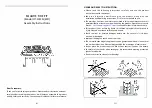
10
Temco PVF7400 Series
78186
NOTE: The gas line connection may be made of rigid
pipe, 1/2” copper pipe or an approved flex connector.
Since some municipalities have additional local codes,
it is always best to consult your local authorities and
the current CSA - B149.1 installation code in Canada
or National Fuel Gas Code ANSI Z223.1 in the U.S.A.
Refer to this code for proper pipe sizing.
IMPORTANT: Always check for gas leaks with a
soap and water solution. Do not use open flame
for leak testing.
1/2” Gas
Supply
CSA Listed 1/2” Shut-off Valve
*Flexible Tube
FP297a
Fig. 10 Typical gas line connection.
*Min. 1/2” Flexible Tube
Required in the State of
Massachusetts
Sediment Trap
A sediment trap shall be installed as close to the inlet
of the equipment as practicable at the time of equip-
ment installation. The sediment trap shall be either a
tee fitting with a capped nipple in the bottom outlet as
shown below or other device recognized as an effec-
tive sediment trap.
3"
Min.
Gas Supply Inlet
To Equipment
Inlet
Tee Fitting
Nipple
Cap
T172
Fig. 11 Sediment trap.
Gas Connection
Check Gas Type. Use only the gas type indicated on
the heater's rating plate. If the gas type indicated on
the plate is not your type of gas supply, DO NOT
INSTALL. Contact your dealer for the proper model.
WARNING
DANGER OF PROPERTY DAMAGE,
BODILY INJURY OR DEATH.
WARNING: Connecting directly to an unregu-
lated LP tank can cause an explosion.
Make sure the heater is equipped to operate on
the type of gas available. Models designated as
natural gas are to be used with natural gas only.
Heaters designated for use with liquefied petro-
leum (L.P.) gas have orifices sized for commer-
cially pure propane gas. They cannot be used
with butane or a mixture of butane and propane.
Gas Piping. The gas supply line must be of an
adequate size to handle the BTU/HR requirements and
length of the run for the unit being installed.
Determine the minimum pipe size from the piping size
chart on Page 11. The normal gas connection at this
appliance is 1/2" NPT made at the left of the unit.
Always use an an external regulator for all LP installa-
tions to reduce the supply tank pressure to a maximum
of 14" w.c. This is in addition to the regulator fitted to
the heater.
All piping must comply with local codes and ordinances
or with the National Fuel Gas Code (ANSI Z223.1),
whichever applies.
Gas Connection. If installation is for L.P. gas, have
LP installer use two-stage regulation and make all
connections from storage tank to heater. Refer to the
National Fuel Gas Code for the proper supply tank size
with the BTU's/Hr requirements. If this is the ONLY gas
appliance, we recommend a minimum 200 pound
cylinder with a fill gauge. Use of a 100 pound cylinder
is not recommended. Other household gas appliances
may require the tank size to be larger. Do not operate
the vent-free heater if the fuel level in the propane tank
is below 1/4 full.
Use pipe wrenches when making the connection to the
valve to prevent turning or damage to gas valve.
Connection between the manual shutoff valve and the
gas valve can be made with an CSA design certified
flexible connector if allowed by local codes. A drip leg
(sediment trap) must be installed, (see gas line
installation). Tighten all joints securely.
CAUTION: Failure to install a drip leg (sediment
trap) may result in improper combustion that will
produce soot. Reference Sections 3.7 and 5.5.7
and Figure 5.5.7 of the National Fuel Gas Code for
guidance.
Under no circumstances should internally zinc
alloy coated piping be used. According to the LP-











































